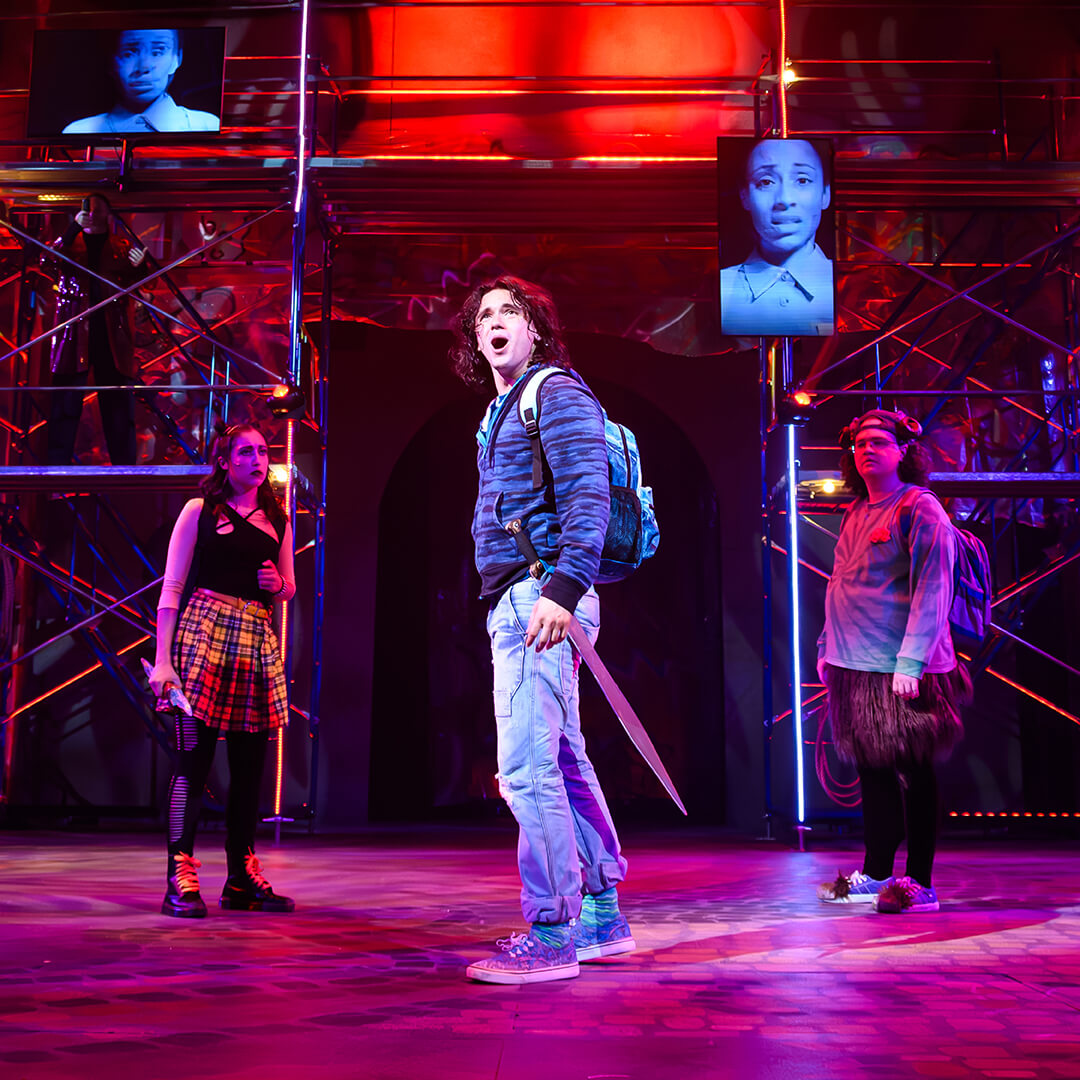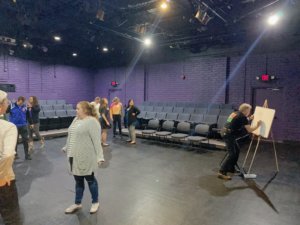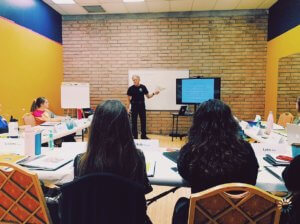
Theatre at Home- The Lightning Thief: The Percy Jackson Musical
Continue the adventure after the show...
Learn MoreOrlando Family Stage
The Finest in Family Theater
Orlando Family Stage joined the Partners In Education Program at the Kennedy Center for Performing Arts in Washington D.C. in 2012 and serves as a leader in Arts Integration programming in Central Florida. Every two years we bring a master teacher to Orlando to hold a three-day Arts Integration and residency development seminar. This year, UCF Theatre for Young Audiences 1st year graduate student Sage Tokach journaled on her experience! Read about her three-day journey here!
Thursday
8:30am: My graduate cohort and I braved the December downpour and bumper-to-bumper traffic to convene at Orlando Family Stage for an arts integration intensive. We had just finished our first semester finals, so our bodies felt completely exhausted. However, as soon as we stepped into the Orlando Family Stage lobby, the holiday decorations, free breakfast, and influx of Central Florida educators reinvigorated us for three days of building connections, lesson plans, and knowledge.
9am: Randy, our laid-back, Kennedy Center teaching artist and dance aficionado introduced himself to our group. After working as a dancer, educator, and choreographer across the country, Randy now lives in New Mexico, leading workshops and residencies under the alias, “Owl Dancer.” His facilitation began with the story of “The Blind Men and the Elephant,” in which six blind men encounter an elephant and each describe it based on one of its body parts. None of them understand the entire idea of the elephant because they only have access to a small section. Like the blind men, the other educators and I each had our own perceptions and experiences with arts integration, but Randy hoped to help us comprehend the whole scope.
Arts Integration is an approach to teaching in which students construct and demonstrate understanding through an art form. Students engage in a creative process which connects an art form and another subject area and meets evolving objectives in both.
11am: Randy led us through a cross-disciplinary science and dance lesson, where we created original choreography to explain the digestive system. Each of us chose a food (I chose Jell-O) and used our bodies to demonstrate chewing, swallowing, churning, absorbing, and expelling. Then, we worked in groups to create a physical representation of the human heart pumping blood. My group included Luke, a United Cerebral Palsy (UCP) campus educator and elementary music teacher, who added a rhythmic beat to enhance our silent movement.
1:30pm: The Kennedy Center definition of arts integration is a bit of a doozy, so Randy broke it down into small segments, which we choreographed one-by-one. This time, my group included Shelley, a middle school science and social studies teacher, Molly, the associate curator for community engagement at the Orlando Museum of Art, and Lydia, a UCP educator. By the time we completed all of the segments, we were able to perform a fluid, dynamic dance that physicalized the definition and committed it to memory. This lesson transformed the long, academic definition into a tangible series of components that I understood and could confidently apply to my work.

Friday
9am: Yesterday, we ate our breakfasts silently, as strangers. Today, we knew each other’s passions and had much more to discuss. Randy started our day with a mingle session that allowed us to continue our conversations a bit longer. I was thrilled to speak with Jenn Benner, Curriculum Director of ArtReach Orlando, who is creating art residencies that deal with identity, physical and mental health, agriculture, and other topics I want to address through my art. Arts education is a collaborative field, so each connection gave me ideas for future partnerships and learning opportunities. The UCP educators and school teachers helped me understand Florida standards and explained which types of programs would be successful as school residencies. Jenn provided an entirely different perspective, incorporating visual arts into the conversation and discussing potential projects that would combine both of our art forms.
10am: Randy introduced the five-step residency plan that we will be following for the remainder of the intensive, eventually creating individual teaching artist residency proposals that we could market to schools. The giant binder of papers to complete seemed daunting, but Randy promised to lead us through the process. First, we chose a fixed residency plan, meaning we would create a series of lessons that could be adapted and marketed to specific school needs.
11am: We finally had to separate ourselves from our beautiful group of new friends in order to choose a topic for our unique residency. Some participants already had ideas they could implement in a school, like Danielle, who wanted to teach her second grade class the properties of matter through dance. My graduate cohort and I knew we would have to market our residencies to schools and hope administrators were interested, so we brainstormed extensive lists of possible art and curriculum combinations. Thanks to my UCF classes this semester, I have become interested in new forms of puppetry, particularly those meant for teenagers and adults. On the academic side, I considered my own high school experience and immediately thought of my health education class. I would have benefited from a more comprehensive understanding of mental health, eating disorders, and body image. To combine these areas of interest, I wanted to use object theatre, a form of puppetry where everyday objects are personified as characters. The students would create some type of story using health-related objects (scales, food, mirrors, exercise equipment, etc.) as characters.
1pm: Thankfully, our individual projects didn’t require us to completely isolate ourselves from the brilliant educators in the room. Between each step, Randy had us ask questions and offer feedback in pairs. For me, the feedback was particularly helpful when it came to matching my residency with the right education standard. My educator partners helped me choose an eighth grade health literacy concepts standard that fit with my idea and informed the details of my project.
The focus on media and technology narrowed the scope of my idea and provided context for the classroom performances. I wanted students to observe various health-related advertisements they would see daily on apps like Instagram and YouTube, analyze their messages, and create better ads through object theatre.
2pm: After choosing a topic, we determined specific goals for both subjects in our residency. Of course, we wanted students to gain knowledge, skills, and appreciation for the curriculum subject area, but we also wanted them to learn an equal amount about our art form. This step helped us achieve true arts integration, where the art form and curriculum support each other, rather than compete. I developed several goals that each connected back to the arts integration definition:
4:30pm: With a solid base for our residencies, we said goodbye, feeling physically exhausted but artistically invigorated.

Saturday
9am: By the last day of the intensive, our timidity had dissipated, and Randy had to wrangle our lively discussions in order to start the day. We kicked off the morning with living sculptures inspired by arts integration quotes. My group created a gentle sculpture and sang our quote as a lullaby.
10am: Back in the classroom, Randy introduced the layers of residency planning, starting with a general outline that describes one overarching task per day. Next, we created a bulleted outline for each day that we would present to the classroom teacher. Finally, we broke those bullets down into five minute segments. That was the true test because I often get excited about certain activities and pack a day unreasonably full.
12pm: Before lunch, Randy led a game that invited us to say the truth about ourselves and see how many of our peers resonated with the statement. We started with silly statements about our love for sports and food preferences, but Randy eventually directed us to speak on our mental process throughout the workshop. We soon delved into our artistic strengths, frustrations, and fears. The whole group didn’t always agree with each statement, but it was reassuring that someone always felt the same way.
2pm: The last afternoon of our intensive was dedicated to the title and description of our residency proposal. This step looked the simplest on paper but was the hardest part of the process for me. After several brainstorming and editing sessions, I settled on “Manipulating Media: Advertising positive health behaviors through puppetry.” Shelly, the science and social studies teacher, came up with the best title. Her residency that incorporated dance into a lesson about the states of matter was called “It Matters: Physical Science Through Movement.” Thanks to group feedback and Randy’s expert eye, we each ended up with a residency we felt proud to develop and present to teachers.
4pm: After wishing Randy well and exchanging contact information with our new educator friends, our inspiring little group parted ways. Though my graduate cohort and I felt like we could lay down and sleep for years, the intensive was the perfect way to close our first semester, and we have already started discussing the next steps for our arts integration careers when we return in the new year.
If you are interested in bringing an Arts Integrated residency or workshop to your school, contact [email protected]
Don't miss out on the magic. Grab your tickets now and
make unforgettable memories at Orlando Family Stage!